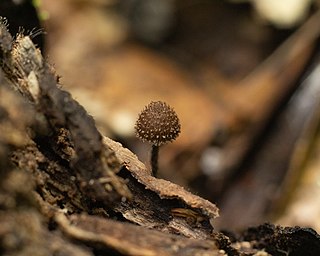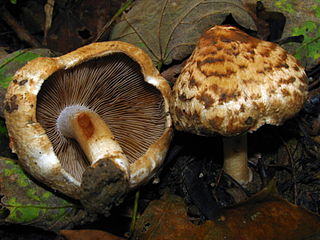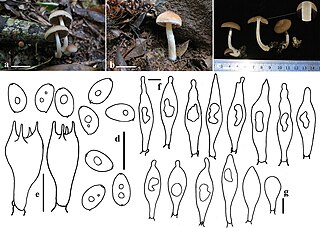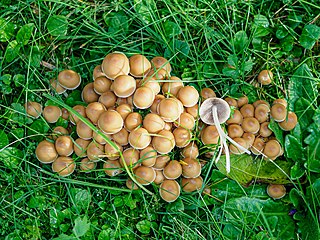
Coprinellus is a genus of mushroom-forming fungi in the family Psathyrellaceae. The genus was circumscribed by the Finnish mycologist Petter Adolf Karsten in 1879. Most Coprinellus species were transferred from the once large genus Coprinus. Molecular studies published in 2001 redistributed Coprinus species to Psathyrella, or the segregate genera Coprinopsis and Coprinellus.

Parasola is a genus of coprinoid mushrooms in the family Psathyrellaceae. These small frail fungi have translucent caps where the radiating gills look like the spokes of a parasol. In the past these mushrooms were classified under Coprinus, but unlike that genus there is no veil and the caps do not really turn to ink, but curl up and wither.

Aspicilia is a genus of mostly crustose areolate lichens that grow on rock. Most members have black apothecia discs that are slightly immersed in the areolas, hence the common name"Given the same reason, the naming of Aspicilia is derived from the Greek word for "shield concave".
Tulosesus marculentus is a species of mushroom producing fungus in the family Psathyrellaceae.
Rhizochaete is a genus of nine species of poroid crust fungi in the family Phanerochaetaceae. The genus is closely related to Phanerochaete. Aside from the widespread Rhizochaete radicata and the Asian species R. borneensis, the remaining Rhizochaete fungi are found in North and South America.
Acanthosphaeria is a genus of fungi in the family Trichosphaeriaceae. The genus was circumscribed by Wilhelm Kirschstein in 1939.

Amaurodon is a genus of fungi in the family Thelephoraceae. Most species in the genus have resupinate and corticioid fruit bodies that grow on rotting wood. The hymenophore may have pores, teeth, or be smooth, and is typically blue to green in color.

Cystoagaricus is a genus of fungi in the family Psathyrellaceae. The genus contains four species found in subtropical America. The genus was circumscribed by mycologist Rolf Singer in 1947, with Cystoagaricus strobilomyces as the type species.
Phlebiella is a genus of crust fungi in the order Polyporales.

Circinaria is a genus of crustose lichens in the family Megasporaceae. It was circumscribed by Johann Heinrich Friedrich Link in 1809.

Inocybe fraudans, commonly known as the pear fibrecap, is an agaric fungus in the family Inocybaceae. It has a yellowish-brown fibrillose cap and stipe that develops reddish tints with age. The flesh has a characteristic odor, similar to jasmin or ripe pears, although the mushroom—like many in the genus Inocybe—is suspected to be toxic. It is found in Europe and North America, where it grows in woodlands. Fruitbodies produce an walnut-brown spore print, and have smooth, almond-shaped spores measuring 8–11.5 by 5–7 µm. Many authors have erroneously referred this species to Inocybe pyriodora.

Psathyrella spadicea or Homophron spadiceum, commonly known as the chestnut brittlestem, is a species of agaric fungus in the family Psathyrellaceae. The fungus was originally described by German mycologist Jacob Christian Schäffer in 1783 as Agaricus spadiceus. Rolf Singer transferred it to the genus Psathyrella in 1951, in which it was classified in the section Spadiceae. In 2015 Örstadius & Larsson recreated the genus Homophron for a group of psathyrelloid mushrooms with no veil and with light-coloured spores, and P. spadicea was moved to the new genus.

Leucogyrophana is a genus of fungi in the family Hygrophoropsidaceae. The genus was erected in 1958 to accommodate the species then known as Merulius molluscus. Several more species were described, but DNA testing in 2001 found that L. mollusca was isolated genetically from the others, and most closely related instead to Hygrophoropsis.
Kauffmania is a monotypic genus of fungi belonging to the family Psathyrellaceae. The only species is Kauffmania larga.
Sagedia is a genus of lichen-forming fungi belonging to the family Megasporaceae.

Typhrasa is a genus of fungi in the family Psathyrellaceae. It contains four species:

Britzelmayria is a genus of fungi in the family Psathyrellaceae.











